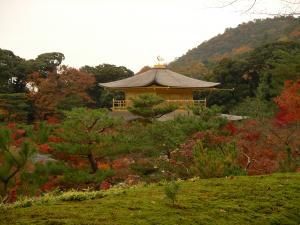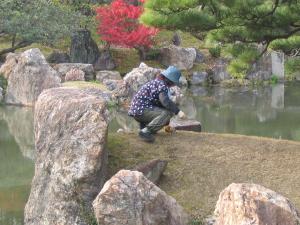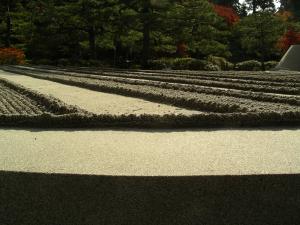
 The Golden Pavilion
The Golden Pavilion
When I decided it was time to visit Kyoto, I wrote to Dan, my goatee, art-philosophy double-major college friend, whose path to that city had run through manga, comics, then classic prints and finally the language. He had lived there for two years. What did he think of it? “It’s nice,” he wrote, “but not what we read in the textbooks.”
I hadn’t expected it to live up to the textbooks. I remember slide after exquisite slide in my college pre-modern Japan class, mostly Kyoto. Everyone talked of how the U.S. military spared Kyoto from carpet-bombing because it was too beautiful to destroy. Still, I wasn’t prepared for what I saw.
A composite
Most books describe Japan as a hybrid: the pull of both the modern and the traditional, the skyscrapers and the tea houses. Some focus on an older combination: an imported Chinese/Buddhist culture, with its ornate architecture, and the simpler, more fleeting "native" Shinto aesthetic. There are truckloads of books and dissertations that discuss these dichotomies, but Kyoto is a composite in a more profound and surreal sense. It is two cities, stitched and patched unevenly together so jarringly that when in one, it is hard to imagine the other is in the same country, much less around the next block.

 Trimming the grass with clippers
Trimming the grass with clippers
One of these cities is that classic Kyoto, the one the State Department is said to have determined a world treasure, the one that I read about in the textbooks, watched slides of in class. It is made up of the stunning gold and silver pavilions, the grand Imperial Palace Park, the Nijou Castle with its singing “nightingale” floors. When wandering through temple gardens, all is in place. The shrubs and trees have been meticulously groomed, combed and coached into positions, perfectly integrated into their settings from every direction. Gardeners on their hands and knees cut the grass with miniature clippers. It is easy to imagine the imperial court of days past whiling away the days composing linked verse.

 A Dry Garden
A Dry Garden
There are also the Zen gardens: wet gardens, centered on lush ponds with a delicate island in the center, dry gardens of improbable waves and cones of meticulously raked gravel. Here the samurai or monks would meditate, striving towards enlightenment.
In addition, there is Gion, with its dark streets and exclusive teahouses and restaurants behind unmarked, silent doors and walls of dark wood. The air is so heavy with Period, I wondered if I hadn’t stumbled into a movie set.
Though I knew what awaited me outside the temple and palace gates, every passage jarred. Outside the gates of these little islands was the other Kyoto. It reminded me of the cold, gray utilitarian cities I remembered from my years in Russia, the primary contrast being that the Russian cities actually had more color. The automobile roads were wide and the sidewalks unfriendly. With few exceptions, the streets were dead, with none of the energy with which a city compensates the traveler for the missing greenery. This city’s style was not modern; it was missing entirely.
To the extent it could claim any modern architectural landmarks, these would be the widely-reviled Kyoto Tower and the new train station. The train station, though remarkable from the inside for its staircases that lead up into the sky, is a concrete jumble from without, and Kyoto Tower is so unremarkable I can find nothing to say about it.
It’s not that this Kyoto is particularly eye-wrenching or that it is necessarily a bad place to live. I know many who lived there and loved it. It is simply so unremarkable that anyone passing through would likely forget having been there when recalling their travels.
All cities have their highlights, and there is always some travel time in between. In my favorite cities, it is this exploration of the space between the spectacles that I love the most. I travel above ground wherever possible, to watch the city pass. The spots I return to over and over are not in the guidebooks, a little somethings I saw on the way somewhere.
In Kyoto, there was nothing to see between the highlights. As I bounced between these scattered landmarks, one isolated from the next, I began to feel like the modern, in-between Kyoto was a sort of wormhole, another dimension through which one must pass to get from different locations that are all in the same city, but by chance or fate, not spatially connected.
This feeling of slipping between worlds was intensified by the fact that they were populated by distinct peoples. In Taipei, where I live now, the temples are living spaces, full of incense and prayer and divination. There are tourists, but the temples aren’t for tourists. The temples in Kyoto were frozen museum pieces through which only vacationers and curators moved. I am used to cramped city dwellers spilling out into the parks and open space, enjoying the sun and their friends; in Kyoto’s scenic spots, everyone had a camera.
I was leaving Kyoto, confused and uncertain about what I had seen, what impression I should take away, when Dan handed me a book. “It really makes you hate Japan after you read it,” he said, “but it’s good.”
Alex Kerr's Dogs and Demons is a lament, a god to today’s expats in Japan, mourning the Japan he fell for, bitterly chronicling the wholesale ransacking of the culture that had been the focus of his life. He writes of a time before Kyoto's shrines were islanded in a swamp of modernity. As he looks at Kyoto now, those remaining oases of old are nothing; he sees only devastation replacing quiet, cobblestone streets. His cry is holistic, but the few numbers he does marshal are convincing enough: a full third of the 13,000 Kyoto historical monuments listed by the Architectural Institute of Japan in 1980 are gone.
Kerr complains that foreigners who come to Kyoto now see only the beautiful monuments, not the gaping holes in between. We don’t realize what a sorry remnant these make, that travel writers who wire in glowing reports must have closed their eyes as they bused from Nanzen-ji to Saihou-ji.
I devoured the book, but Kerr’s response to those Kyoto love letters I’d read in magazines did not provide the coherence I was looking for, only more dichotomy. Perhaps Kerr was right that I had to have been there back when, however, I couldn’t see one of the world’s greatest collections of palaces, temples and museums as a sorry relic. I’ve never seen their like: Daitoku, the serenely Zen city of temples set against goldened maples; the Silver Pavilion, seen from quiet, winding trails through hills blanketed by manicured moss; the Imperial Gardens, broad and stately; Kiyomizu-dera, a massive temple delicately perched on a steep sleep, braced by impossibly long wooden legs.
“Yet though gardens and temples are wonderful things,” Kerr reminded me, “world-heritage sites do not a city make. Streets and houses make a city…”
I haven’t written a book and I’m not the dean of anything, but I did major in math, and I think he’s done it wrong: they make two cities.
Joshua K Hartshorne is a freelance writer based in Boston. He moonlights as a cognitive scientist at the Cognition and Language Laboratory.